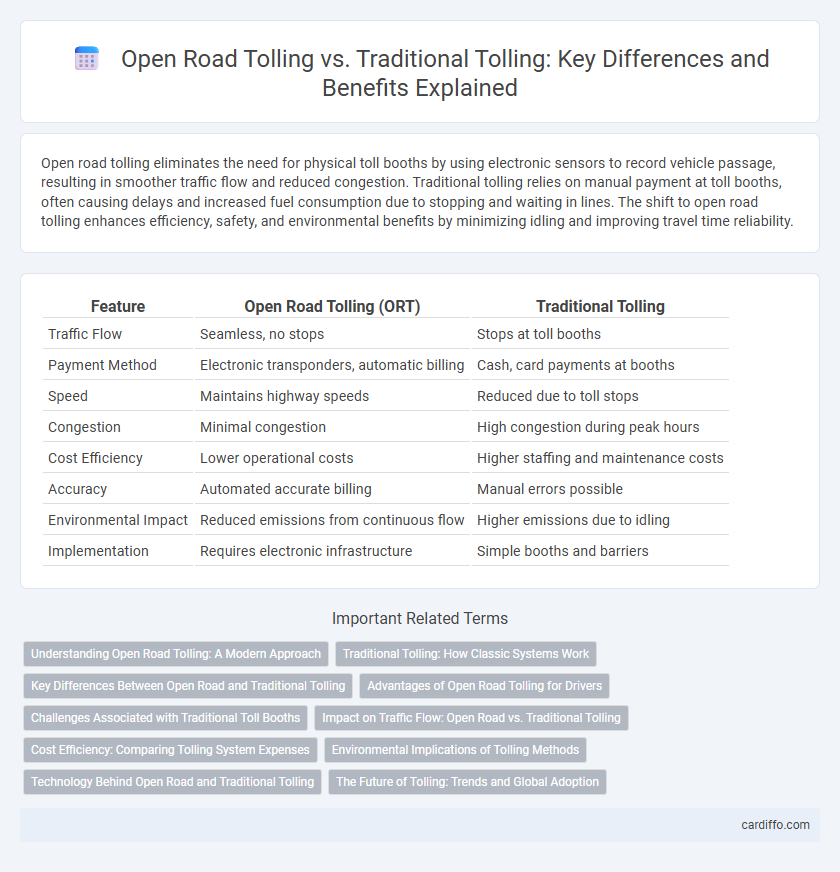Open road tolling eliminates the need for physical toll booths by using electronic sensors to record vehicle passage, resulting in smoother traffic flow and reduced congestion. Traditional tolling relies on manual payment at toll booths, often causing delays and increased fuel consumption due to stopping and waiting in lines. The shift to open road tolling enhances efficiency, safety, and environmental benefits by minimizing idling and improving travel time reliability.
Table of Comparison
| Feature | Open Road Tolling (ORT) | Traditional Tolling |
|---|---|---|
| Traffic Flow | Seamless, no stops | Stops at toll booths |
| Payment Method | Electronic transponders, automatic billing | Cash, card payments at booths |
| Speed | Maintains highway speeds | Reduced due to toll stops |
| Congestion | Minimal congestion | High congestion during peak hours |
| Cost Efficiency | Lower operational costs | Higher staffing and maintenance costs |
| Accuracy | Automated accurate billing | Manual errors possible |
| Environmental Impact | Reduced emissions from continuous flow | Higher emissions due to idling |
| Implementation | Requires electronic infrastructure | Simple booths and barriers |
Understanding Open Road Tolling: A Modern Approach
Open road tolling (ORT) eliminates the need for physical toll booths by using electronic sensors and cameras to identify vehicles and automatically charge toll fees. This system reduces congestion, improves traffic flow, and minimizes operational costs compared to traditional tolling, which requires vehicles to stop at toll plazas for manual or automated payment. ORT enhances efficiency through real-time data collection and seamless integration with electronic toll collection accounts, offering a modern solution for road infrastructure funding.
Traditional Tolling: How Classic Systems Work
Traditional tolling relies on physical toll booths where drivers stop to pay tolls manually using cash or credit cards, causing traffic delays and congestion. These classic systems utilize barriers and toll collectors, resulting in slower traffic flow and increased operational costs due to staffing requirements. Toll plazas often lead to bottlenecks and longer commute times compared to modern open road tolling technologies.
Key Differences Between Open Road and Traditional Tolling
Open road tolling eliminates the need for toll booths by utilizing electronic toll collection systems such as RFID tags and license plate recognition, allowing uninterrupted traffic flow and reducing congestion. Traditional tolling relies on physical toll plazas where vehicles stop to pay, causing slowdowns and increased emissions due to idling. Open road tolling enhances efficiency and safety while reducing operational costs compared to the manual labor and maintenance required in traditional toll collection.
Advantages of Open Road Tolling for Drivers
Open road tolling eliminates the need for drivers to stop or slow down at toll plazas, significantly reducing travel time and fuel consumption. This system enhances traffic flow and decreases congestion, leading to a smoother and more efficient driving experience. Electronic toll collection improves convenience and accuracy, minimizing human error and reducing operational costs for drivers.
Challenges Associated with Traditional Toll Booths
Traditional toll booths often cause significant traffic congestion, leading to longer travel times and increased vehicle emissions. Manual payment systems at toll booths increase the risk of human error, delays, and higher operational costs for maintenance and staffing. Additionally, traditional toll booths can pose safety hazards due to frequent stopping and merging, contributing to accident risks on busy highways.
Impact on Traffic Flow: Open Road vs. Traditional Tolling
Open road tolling (ORT) significantly improves traffic flow by eliminating the need for vehicles to stop at toll booths, allowing continuous movement and reducing congestion. Traditional tolling requires vehicles to slow down or stop, causing bottlenecks and increased travel time, especially during peak hours. Studies show that ORT can increase traffic throughput by up to 30%, enhancing overall roadway efficiency and reducing emissions associated with idling vehicles.
Cost Efficiency: Comparing Tolling System Expenses
Open road tolling (ORT) significantly reduces operational expenses by eliminating toll booths and minimizing labor costs, leading to lower infrastructure maintenance fees compared to traditional tolling systems. Traditional tolling requires physical toll plazas, which incur higher costs related to construction, staffing, and vehicle congestion management. Implementing ORT enhances cost efficiency through automated electronic toll collection, which streamlines transactions and reduces overall system expenses.
Environmental Implications of Tolling Methods
Open road tolling significantly reduces vehicle emissions by eliminating the need for cars to stop or slow down at toll booths, leading to smoother traffic flow and lower fuel consumption compared to traditional tolling. Traditional tolling often causes congestion and idling, which increases carbon emissions and air pollution near toll plazas. Transitioning to open road tolling supports sustainable transportation goals by minimizing environmental impacts associated with vehicle stoppage and acceleration cycles.
Technology Behind Open Road and Traditional Tolling
Open road tolling utilizes advanced electronic toll collection systems, such as RFID transponders and automatic license plate recognition cameras, to enable seamless vehicle identification and payment without stopping. Traditional tolling relies on physical toll booths where cash or card payments are manually processed, causing delays and congestion. The technology behind open road tolling enhances traffic flow efficiency and reduces operational costs by eliminating the need for toll booths and manual labor.
The Future of Tolling: Trends and Global Adoption
Open road tolling (ORT) is revolutionizing global transportation by eliminating the need for toll booths, enabling seamless vehicle flow and reducing congestion on highways. Traditional tolling systems, reliant on cash or card payments at physical plazas, face increasing challenges with traffic delays and maintenance costs, spurring governments worldwide to adopt ORT technologies such as RFID and ANPR. Trends in the future of tolling highlight the integration of smart infrastructure, data analytics, and mobile payment platforms to enhance efficiency, reduce emissions, and support dynamic pricing models across regions including Europe, North America, and Asia.
Open road tolling vs Traditional tolling Infographic

 cardiffo.com
cardiffo.com